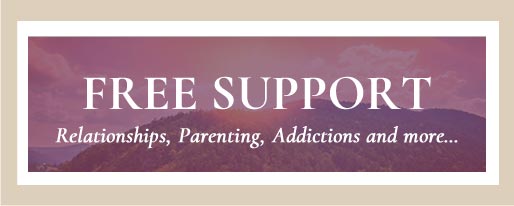Frustration and Rage
By Sheryl PaulJanuary 16, 2013
How do you handle your child's frustration and rage? How do you handle your own big feelings? The two questions are intimately connected. Read on to understand how!
Just as I’m about the pour a splash of vanilla into the shake I’m making for my son, I hear two blood-curdling screams followed by the sight of my older son, Everest, tearing around the corner with his 3 1/2 year old brother, who has transformed into the Tazmanian devil, close behind. Everest dashes behind my back to create a blockade between him and Asher. Asher runs full-force toward his brother, but finds himself in my arms instead.
I carry him to the couch and hold him tightly. Contained in my arms and against the warmth of my skin, the flailing in his body quickly stops, but he continues to scream at the top of his lungs for several minutes. I put my face close to his to let him know that I’m here and to send the silent message that it’s okay to scream. Everest watches from the safe distance of the hallway, still rattled by the intensity of his brother’s rage directed at him. When the frustration has passed through him, Asher is quiet. I hold him and kiss him. He looks up at me with his big, brown eyes, his cheeks wet with tears, and says, “I had to tear the paper out of my notebook. I needed a bookmark.”
“I know, sweetheart. And that was so frustrating when Everest didn’t understand.”
Silence.
“And you ran after him because you were so angry and frustrated.”
Silence. But I know the words are going in. I know how important it is to re-tell the story so that he can begin to process it and make sense of his big feelings.
“And it’s okay to feel angry and frustrated, but when you chase Everest he feels very scared. When you’re frustrated, instead of chasing Everest, you can scream and hit the pillows, or run around the house. Or we can practice what we learned in Steps and Stones.”
Silence, but he’s listening to every word. I know from raising Everest that it will take hundreds of conversations (literally) before the words sink in and change happens. That means hundreds of times of him behaving in ways that aren’t loving to others or himself before he can assimilate the message and make a different choice.
From my work with clients and reading parenting books in Everest’s early years, I know that the dominant parenting message supports of a punitive model of discipline. Culturally we support tools like “time outs” and “logical consequences” as a way to teach “good” and “bad” behavior. While I do believe that it’s possible to apply these techniques in a way that doesn’t negatively affect a child, more often than not the message that is communicated is, “Big feeling are bad. If you’re going to scream, go to your room. If you hit Charlie, you need a time out.” These techniques may work in the short run, and certainly achieve faster results than what I’ve described above, but they typically leave unseen scars and transmit unhealthy messages about big feelings.
We also sanction distraction techniques, so when a child is crying loudly an adult walks over with a toy or video game to get him to stop. Again, distraction certainly has its place in parenting, but usually the overarching message is, “Your big feelings are not okay.” Why do we feel a need to stop a child from crying loudly?
From my work with clients, it’s clear that the single most common cause of anxiety is learning early in life that big feelings are unmanageable and that one’s self-worth is dependent on “good” behavior. Obviously, from a parents’ perspective, good behavior is defined as quiet, calm, and reasonable. Thus is born the “good boy” or “good girl” syndrome where a child’s true nature is stuffed away deep inside because he or she learns that grown ups are uncomfortable with big feelings and that if she wants their approval, she has to be good in order to get it. And, of course, parents are uncomfortable with big feelings when they haven’t done the work necessary to heal from the unhealthy messages absorbed from their childhood about their own feelings.
The entire interaction with Asher lasted less than five minutes. It doesn’t take a long time in the moment to teach kids that they can handle big feelings and that loud feelings like frustration and anger are okay, but it is dependent on a relationship of trust, and repetition, patience, and taking the long view are key. When Asher cried as a baby in the middle of the night, I held him through it. When he screamed in the car as a two month old, I did my best to soothe him, and often pulled over to nurse him or comfort him in other ways. When he throws everything off the coffee table in frustration because he can’t fit two Lego pieces together, I gather him up, hold him close, and let him know that his frustration is okay. When the storm passes, we talk about other, less destructive, ways to handle frustration. Both of my boys also learn about big feelings by watching how I handle the other one. As I sat with Asher on my lap, Everest witnessed the entire interaction. And when it was over, Asher walked over to his big brother and said he was sorry – an authentic expression that wasn’t motivated by me saying, “Now, say you’re sorry”. Then they ran off to continue their game.
And where was I? Ah, yes, the splash of vanilla…
***
Three notes:
1. There are certainly times when my exhaustion collides with his frustration and I lose my patience. At these times, I make sure of two things: 1. That I apologize for snapping at him and 2. That I don’t make it his responsibility that I snapped at him. In other words, it’s easy to say, “I’m sorry I snapped at you but if you weren’t so loud or whiny, I wouldn’t lose my patience,” but my impatience is 100% my responsibility and nobody can “make” me lose it. Parenting isn’t about responding “perfectly” every time (impossible), but it is about role-modeling responsible behavior and being honest about our humanity. So if I can’t do what I described in the blog post, I can model for him what accountability looks like, which is equally as important. A friend once shared with me something her therapist said to her which has always stuck with me: “Relationships aren’t about being perfect. You’re going to lose it with your partner or with your kids. What matters is the repair.”
2. Asher is my second child, and I have infinitely more tolerance for his big feelings than I did with Everest. Even though I had a lot of space for my own big feelings when I became a parent, nothing could have prepared me for how helpless I felt around Everest’s big feelings. As a highly sensitive child, he struggled in many areas where easy-going babies didn’t: at the grocery store, around new people, at bedtime and throughout the night. He struggled with transitions and he struggled with loud noises. (He no longer struggles in any of those areas.) It took me two years to realize that he was a highly sensitive child, and another several years before I developed ways to help him handle his big feelings. I could look back at some of my parenting choices in his earlier years and fall prey to a critical voice that says, “You screwed up”. Or I could choose to view myself through a compassionate lens that says, “I did the best I could. It’s only about learning.” I choose the latter.
3. There are certainly times when distraction is not only understandable, but necessary. When Asher’s frustration is the result of exhaustion or a negative reaction to food, I don’t think there’s anything beneficial in supporting his emotional meltdowns. Distracting with music, play and humor, or books helps him break out of his negative cycle and restore his equilibrium. Of course, it’s not always easy to discern the source of the frustration, and this is where parenting becomes an art, not a science. You do the best you can, knowing that there are no perfect answers and certainly no perfect parents.
 Send this article to a friend
Send this article to a friend  Print this article
Print this article  Bookmarked 4 time(s)
Bookmarked 4 time(s)
| Related Articles |
|---|
| Parenting: What Do Your Children REALLY Need From You? |
| Following a Child's Lead |
| What Your Children Need |
Comments
| Author | Comment | Date |
|---|---|---|
| Join the Inner Bonding Community to add your comment to articles and see the comments of others... | ||

Daily Inspiration
What path are you really on? Do you stay open as long as things are going your way but retreat to anger or withdrawal as soon as you are displeased with someone or something? Or, do you stay open even in the face of conflict and challenges? Today, be honest with yourself regarding which path you are truly devoted to: The Path of Fear or The Path of Love and Courage.
By Dr. Margaret Paul

 Share with Del.icio.us
Share with Del.icio.us Share with Digg
Share with Digg







